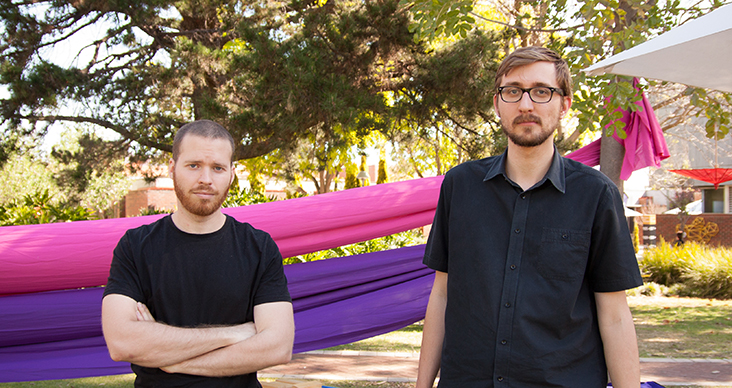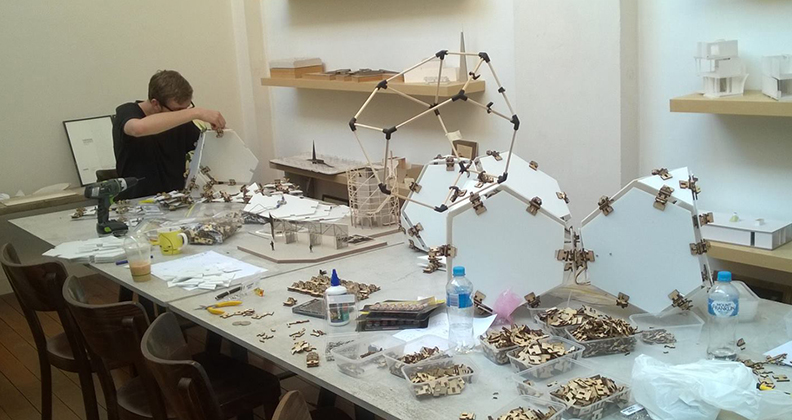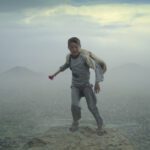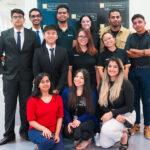Rob Cameron, an architecture graduate applying for PhD candidacy, and Andrei Smolik, a Curtin sessional academic and research assistant, have been stepping into the limelight with their architecture projects. The duo’s ‘cringeMachine’ featured in the Curtin Creative Festival and the University of Western Australia’s (UWA) Research into New Genres of Experimentation, as part of their experiments into interactive architecture.
Can you tell me about your backgrounds?
Andrei: I came to Curtin in 2008 to study architecture. The course was five years: a bachelor degree and two years of masters. I came back and started doing research, and then got into academic discussions and this idea of doing a PhD. I like it. I like the idea of being free to experiment and explore different avenues.
Rob: I have a background in fine arts. When I went to university at UWA, I wasn’t sure whether to go into fine arts or architecture, and I got pushed into architecture. About a year or two into it I realised it was really good, so I decided to keep going with it. I studied my bachelors and masters at UWA, and then after a year off, I started my own business in animation, architecture design and graphic design, //thedeadpixelproject.
I then decided I want to continue researching, so I gave Curtin a go. I have been running the business this year, but I want to put it on hold next year because I want to get into a PhD. Now that I’ve started my PhD, I’ve started to get the opportunity to get back into fine arts, so the work that we’re doing involves a lot of work with interactive public art.
What can you tell me about the cringeMachine?
Rob: The cringeMachine is a prototype for something we’ve been working on for a while, which is experimenting with fabrications and working with cheap found materials. And then my research is to do with interactive architecture, so this work at the moment is fairly rudimentary – it’s more reactive than interactive – but as a prototype it works pretty well. The idea from here is to keep building on that.
Andrei: It’s not so much about the type of interaction. It’s more about the logic of interaction. It’s not really about the lights themselves. It could be sound, it could be lights, it could be temperature changes, it could be anything like that. The point is how do seemingly immaterial objects relate to your real-world experiences as a subject?
Architecture is kind of like the soundtrack to a movie. When you watch a movie, you’re not really paying attention to the soundtrack – you’re paying attention to the story, you’re paying attention to the characters, what’s going on, the interactions – but the music is driving and steering it in the background. It’s the same with architecture. It’s not really something you pay that much attention to, but it’s basically steering everybody’s interactions, even though they’re not noticing it. Our research is about exploring new ways of modifying or experimenting with it, using the materials that Rob mentioned, but also new technologies and some aspects of computation, because computation has started seeping into all fields recently, including architecture. We’re exploring and experimenting really.
How will the cringeMachine help you develop future projects?
Rob: This project is just an opportunity to experiment with ideas. The things we learn we’ll build and apply in future projects.
Andrei: It makes the built environment more interesting. When you go through architecture, you’re being forced to pay more attention to things that you usually wouldn’t pay attention to. Subtle effects on a conscious state are of extreme importance and have a strong influence on what you do. Architecture is not necessarily about buildings per se, it’s the way you think about buildings, which has the potential to link to other fields, so we’re having very interdisciplinary discussions with other people, who don’t necessarily know a lot about buildings, but whose conceptual ideas we can relate to and interact with.
We found that people don’t interact enough and they don’t interact enough with people outside of their field of friends and colleagues. Sometimes it’s good to meet other people that you wouldn’t necessarily interact with – that’s how good ideas are born. When you get exposed to things you wouldn’t get exposed to, it breeds a different way of thinking and a different attitude. It changes your state of mind.
Do you have any dream projects?
Rob: I take projects as they come. Every project is another opportunity and every project is different depending on the concept and the context. More scope is always a good thing.
When you’re dealing with projects, they might be appropriate for one situation, say for instance, putting the cringeMachine inside a tepee is completely different to building something in the middle of a busy public space, which is different to building something in the entryway to the floor of a building. So things like form and structure can be generic, but they shouldn’t be, and interaction on the other hand is something that has to react to context.
Andrei: If I knew what my dream project was, I wouldn’t do it, because I would already know what it is. It’s more fun to do things that you’re not quite sure are going to work. If there’s a risk of failure, it makes it really exciting. If you know how something works, then you don’t need to do it, because you already know it – but if you don’t know, then there are opportunities.
For more information on their projects, contact Rob Cameron or Andrei Smolik, or view Rob’s website, //thedeadpixelproject.





